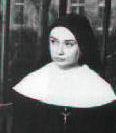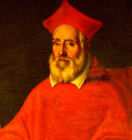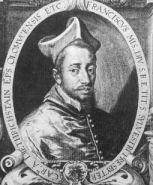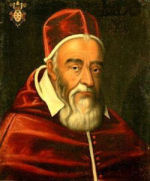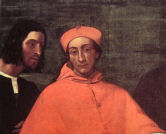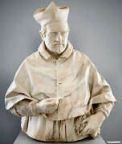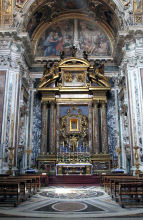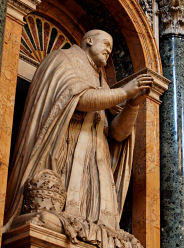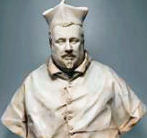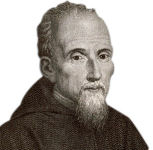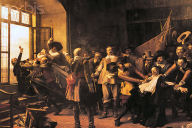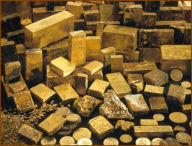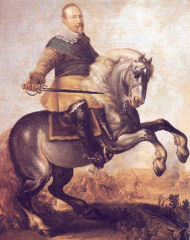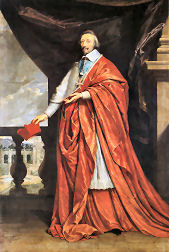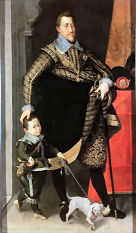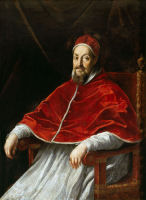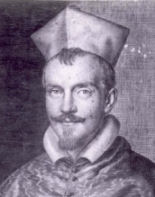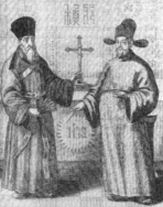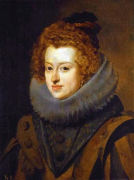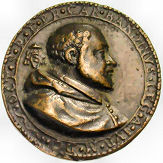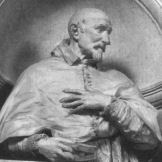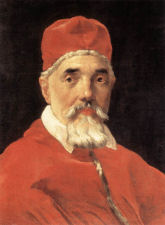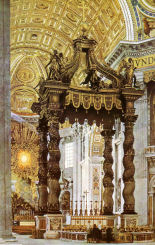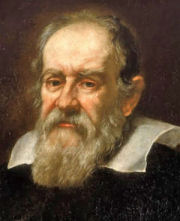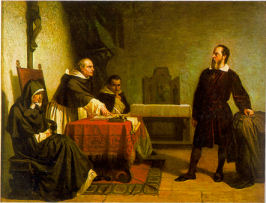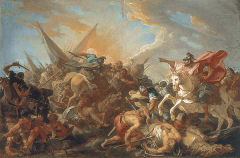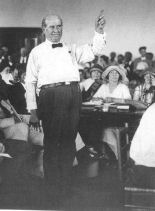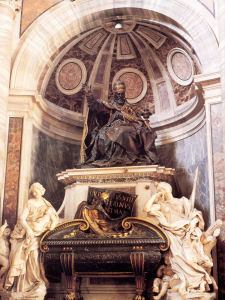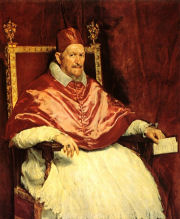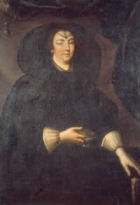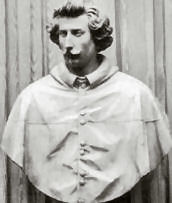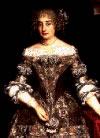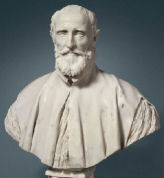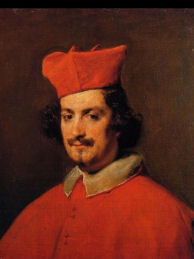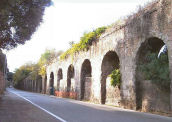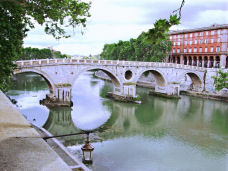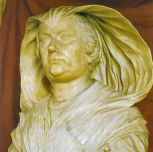Chapter 19: Ignoring the War
1605: Two Conflicted Conclaves
Both conclaves of 1605 merit more attention than the popes that they produced. On Clement VIII’s death in March, sixty-one cardinals assembled in Rome. The two principal factions were the Spaniards, led by Cardinal Avila, and the cardinals associated with the deceased pontiff and his nephew, Cardinal Aldobrandini. The latter proposed Cardinal Baronio (often called Baronius), a Church historian who had written that Spanish claims in Sicily were based on fraudulent documents. The Spanish delegation refused to accept Baronio and circulated enough doubloons to assure his defeat. Here is how Valérie Pirie described what happened next:
Aldobrandini, powerless to stem the tide of defection and now convinced that the Grand Duke (Medici of Florence) and his French allies were the chief culprits in sapping his authority, gathered round him his few faithful adherents and offered his services to his opponents. Avila received him courteously enough, and accepted a compromise on his formal assurance that Baronio's candidature would be withdrawn. In exchange the Spanish leader agreed to lend his support to one of Aldobrandini's followers; but the choice was restricted and the selection they made unfortunate. Aldobrandini soon realised how impossible their candidate was, and did not even attempt to launch him. Avila, thinking he had been tricked, and resenting the cool way in which Aldobrandini had ignored their agreement, took the first opportunity of challenging him publicly to explain his behaviour. Aldobrandini was curt and sullen. The Spaniard stormed and threatened – followers of both parties joined in the argument, which soon degenerated into a mêlée. Conclavists attracted by the commotion took sides and threw themselves whole-heartedly into the fray.
The uproar reached such proportions that the guardians outside the closed doors thought that the Pope had been elected by acclamation and started to break the seals. Fortunately Dietrichstein, an imperial prelate who had held himself aloof from all factions, managed to dominate the tumult. Being a good linguist and evidently a diplomat as well, he persuaded the belligerents that a mere misunderstanding was at the root of the quarrel; that Avila and Aldobrandini had interpreted certain words one in the Spanish and the other in the Italian sense, and that no one was to blame. The excitement died down and a reconciliation took place between the two antagonists, but only a half-hearted one probably, as they never resumed their alliance.
Meanwhile the younger element of the Sacred College, and very young indeed some of its members were, was perpetually getting into mischief in an attempt to relieve the tedium of the proceedings. .... The youngsters organized a series of pseudo adorations. Masquerading cleverly as their elders, coughing, wheezing, bent double and assuming tremulous falsetto voices, they would break in on the slumbers of one of their aged colleagues, dreaming perhaps of the coveted tiara, and prostrating themselves on the floor of his cell hail him as Pontiff. When the deception had taken effect they would burst into peals of laughter, scuttle away and disperse before their victim could recover from his emotion or identify the culprits. Another of their pranks consisted in purloining the sticks and crutches of the cripples under cover of darkness in the chapel, so that the worshippers remained marooned till their conclavists, surprised at such protracted devotions, became suspicious and rescued their masters quivering with impotent rage. Then the young scamps, now completely unmanageable, took to voting for one another, so that four of them, all under twenty years of age, got several voices which sent the old cardinals, who had never had any themselves, into paroxysms of indignation.[1]
Eventually the Medici family emptied its coffers for its own candidate, Cardinal Alessandro Ottaviano de’ Medici, who was elected on April Fool’s Day. Pope Leo XI’s pontificate lasted only twenty-six days. Pressured to nominate cardinals from his sickbed, he refused to do so. His family’s heavy investment in his candidacy yielded nothing but resentment.The next conclave featured essentially the same participants, but money was tighter. Cardinal Aldobrandini successfully thwarted Cardinal Sauli’s candidacy. He then placed in nomination his own candidate, Cardinal Tosco, an unusual choice.
He was both morally and physically the coarsest creature imaginable. His language and manners were those of a vulgar ruffian. Not only was he the most profane of prelates, but he had no more respect for his fellow creatures' feelings than he had reverence for the Church. Yet the candidature of this foul-mouthed, brutal being brought about an agreement between the two contending parties. Montalto and Aldobrandini met in Monti's cell, and the former, having no personal nominee and having noted some symptoms of discord among his “Knights”, yielded, though regretfully, to Aldobrandini's persuasions.In the evening they mobilized their united forces to proceed to the chapel for the scrutiny which was to confer the papal crown on Tosco. From the independent factions such as the French and the Spanish rose cries of protestation and even cat-calls and hisses. The excited conclavists had pushed Tosco out of his cubicle to loot it more conveniently, and as he was ill and could not remain standing for long, he had taken refuge in Dietrichstein's cell, where he remained in the company of his host to await events.
Cardinal Baronio was proposed as an alternative. A shouting match erupted, and it soon deteriorated into a donnybrook. Several cardinals sustained severe injuries. One faction licked its wounds in the Sistine Chapel; the other repaired to the Pauline Chapel. Both prepared for a siege. With the French cardinals mediating, eventually Cardinal Borghese, an uncompromising legal scholar, was chosen as least offensive to both sides. He assumed the Throne of St. Peter as Pope Paul V.[2]
Pope Paul believed that bishops should live in their own dioceses. He tolerated no resistance to this decree, which was extremely unpopular with the many prelates who had established a comfy lifestyle for themselves in the Eternal City. Expulsion of the bishops made room in Rome for the rest of the Borghese family. The pope gave important administrative positions to his two brothers, with whom he met every day. He made cardinals of several nephews, including Scipione Borghese, a key player in upcoming decades. Venice had enacted laws eliminating privileges previously enjoyed by the Church and its clergy. In 1606 two priests were arrested and imprisoned in La Serenissima. Fra Paolo Sarpi argued for Venice in favor of the separation of Church and state. Pope Paul scoffed at the patent absurdity of this position. He excommunicated all the Venetian leaders and placed the city under interdict. To his chagrin, however, almost all the priests in the lagoon stayed there and continued to administer the sacraments. The Venetians never repealed the laws, but after they promised to act with their customary piety, the pope withdrew his censures. He nevertheless placed Sarpi’s work, Risposta di un Dottore di Teologia, on the Index. In 1614 Pope Paul published the Rituale Romanum, which served for 385 years as the official manual for the exorcism of devils and demons.In 1616 Pope Paul personally warned Galileo Galilei not to defend the Copernican theory of cosmology. The problem for the pope was that if the earth orbited the sun, how did one explain God making the sun stop in Joshua 10:13? The problem for Galileo was that each advance in astronomy made the geocentric system more complicated, requiring the planets to wander around in figure-eights and loop-the-loops and occasionally backing up in a sort of Moon Walk called retrograde.[3] The heliocentric system, on the other hand, smoothly accommodated each new discovery. Galileo’s new telescope guaranteed a steady stream of troublesome data.
The Thirty Years War
The most historically significant event of Paul V’s pontificate was the onset of the Thirty Years War. It is often portrayed as Catholics versus Protestants. While most principals on one side were Catholic and on the other side Protestant, there were important exceptions. It has been portrayed as the first war that encompassed the entire continent. However, none of the British Isles took part; Portugal seceded from Spain but did not fight; Italy’s involvement was minimal. It has been described as the Hapsburgs against the rest of Europe. That is pretty close to accurate, although several nations stayed on the sidelines. The Hapsburgs remained united throughout, and they enrolled few allies.It is important to examine Europe’s condition in 1618, when the great war began.
• The Little Ice Age affected everyone in the sixteenth century, and by 1618 crop failures were common, especially in northern Europe and in France, where farmers stubbornly refused to vary their selection of crops. • The Hapsburg family ruled Spain, Portugal, all of the low countries, Germany, Austria, Hungary, central Europe, the Balkans, and much of Italy.• The abundance of shiny rocks that Spain had expropriated from Latin America had rendered it exceptionally wealthy.
• Most warring countries depended on mercenaries rather than standing forces. An exception was King Gustavus Adolphus of Sweden, who brought a disciplined army across the Baltic and routed almost anything that the Hapsburgs’ generals could muster.• In Germany each prince determined his territory’s religion (Lutheran or Catholic). When a noble converted, the inhabitants of his lands followed.
• France enjoyed something approaching freedom of religion, but in most nations orthodoxy was rigorously enforced.
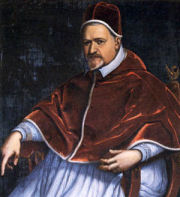
Summarizing the war is difficult. A large number of battles occurred over the course of three decades. There was no discernable front. The sides constantly shifted. Some players, such as the empire and Spain, were powerful and well known all over the continent. Often, however, leading roles were played by relatively small principalities. The fighting was not continuous; during relatively tranquil periods the leaders often spent large sums on mercenaries. Armies disappeared and then reformed. The most distinguished battlefield leaders perished.
Early in the war the empire seemed poised to crush the Protestants, but Emperor Ferdinand failed to press his advantage, largely because of the Spanish navy’s ineptitude. Then, when defeat loomed for the Hapsburgs, the imperial generals garnered important victories. And so, the war dragged on and on and on.In 1648 the Peace of Westphalia concluded the fighting. Squelching the Protestant movement would never again be more than a papal pipedream. The war also dealt a fatal blow to the basis for the entire feudal system – the divine right of kings ratified by the papacy. It would take centuries for this effect to be fully realized, but the eventual downfall of European monarchs, not to mention all those barons, dukes, counts, and princes became inevitable. Some survived, but only as figureheads.
In the short run the war settled little. Staggering numbers perished on both sides for almost nothing. Not only were the battles bloody, but disease, pestilence, and famine exacted an equally horrendous toll. The emperor lost only a little territory. However, the Hapsburg mystique – hereditary power subsidized by gold from the new world – suffered greatly. Spain fared as badly as Germany; Portugal and Catalonia revolted. France, on the other hand, under Cardinal Richelieu’s leadership, kept the fighting off its soil and claimed some new territories. Sweden gained a few parcels of land but lost its beloved king.
The Popes of War
Pope Paul V and his successors were ambivalent about the war. From the popes’ perspective the war mainly formed the backdrop against which other dramas played out in Rome. The first pope elected during the war was a compromise candidate, Alexander Ludovisi in 1621. His most endearing attributes seemed to be advanced age and poor health. Three days after becoming Pope Gregory XV he appointed his nephew Ludovico Ludovisi cardinal and secretary of state. He also found a red hat for another nephew and a cousin. The pope’s brother Orazio was given command of the papal army.The pope and Ludovico were educated by Jesuits. Pope Gregory canonized both Ignatius Loyola and Francis Xavier, founders of the order. He financed Jesuit expeditions that converted enormous numbers in far-flung locations like China and Abyssinia using intelligence, hard work, and, well, whatever else was required. Best not to ask too many questions, right, Sister Mary Immaculata?
Pope Gregory also instituted the Society for the Propagation of the Faith. Due to its proselytical work a good number of capitalist princes in the empire were converted from socialistic-leaning Lutheranism back to the Roman Church. In the early years of the war the papacy also provided economic support to the emperor and Spain. Pope Gregory considered it a simple matter of Christians versus heretics. However, he also awarded a red hat to Richelieu in France, and the cardinal would eventually be a thorn in the emperor’s side. Pope Gregory also tricked Spain, Savoy, and the empire into allowing Orazio’s papal army to seize the Valtelline, an Alpine territory in the far north-central portion of Italy. The most lasting legacy of Pope Gregory’s twenty-nine-month pontificate was his revision of the process of papal selection. His rules are still by and large followed in the twenty-first century. He also granted permission to the son of the King of England to wed the Infanta of Spain. This decree helped curtail the persecution of Catholics in Britain. Since the British never had significant doctrinal disagreements with the papacy, the marriage itself might have steered England back into the Church, but the wedding was called off.Gregory XV issued a “constitution” to curtail the persecution of witches. It referred to the “grave errors that were committed daily by ordinaries, vicars, and inquisitors in witchcraft trials, including the use of defective forms of process, the administration of excessive torture, conviction on the most slender evidence, and the turning over of suspects to the secular courts.”[5] He restricted capital punishment in witchcraft cases to murderers and those proven to have made compacts with the devil. He also circumscribed the use of torture.
Ludovico visited his uncle on his deathbed and beseeched him to appoint additional cardinals so that he (Ludovico) could control the upcoming conclave. Gregory refused, saying that he would “already have to account to God for having made so many unworthy ones.” Indeed, the pontiff named eleven new cardinals in his short tenure.
.
Pope Gregory died on July 8, 1623. The cardinals fervently prayed for a short conclave. Rome has always been intolerable in August; in the seventeenth century not only was the heat stifling, but disease was rampant, and the hygiene was deplorable. In the first few ballots the leading vote-getters were Ludovico Ludovisi’s favorite, Cardinal Bandini, and Cardinal Mellini,[6] Pope Urban VII’s nephew and the standard-bearer for Spain and the Borghese faction. As the conclave dragged on, many cardinals were stricken with fever. The outbreak did not seem to favor one side over the other. “The cardinals’ underclothes remained unwashed. Their cubicles and the passages of the Belvedere quickly fell into a condition of nauseating neglect.”[7] The breakthrough arrived when Cardinal Borghese became seriously ill and sought permission to leave the conclave. The conclave unanimously voted to deny the request! Faced with the startling prospect of his own death in such unpleasant circumstances, Borghese agreed to support the compromise candidate, Cardinal Maffeo Barberini, probably the most insufferably arrogant man to don the tiara since Boniface VIII. Barberini took the name Urban VIII. For centuries nearly every pope had provided for his family. Pope Urban, however, outdid even the master nepotist of the fifteenth century, Pope Sixtus IV, in indulging his relatives. He made cardinals out of three nephews and one brother. The Catholic Encyclopedia states, “It is scarcely credible what immense riches accrued to the Barberini family through Urban’s nepotism.”[8] Williams has written, “The family of Pope Urban VIII was obviously the most excessive of all papal families. … It has been estimated that the Barberini family came into possession of 150,000,000 scudi in the twenty-one-year period when Pope Urban VIII reigned. The Barberini family had acquired Palestrina, Monterotonde, and Valmontone, which Colonna and Sforza families had been forced to sell; they possessed sumptuous palaces, magnificent works of art, gold, silver, and precious stones.”[9] Urban was no friend to the Hapsburgs. He sent the Catholic forces not a single quattrino during his entire pontificate, which covered more than two-thirds of the Thirty Years War. Instead, he spent the treasury on his family, on public works projects (including a statue of himself), and on fortifications. He obsessively pored over blueprints for fortresses and read up on military theory. He also wrote poems, including an ode praising Galileo. He threatened to excommunicate anyone who smoked or took snuff in church because he feared that they led to orgasms.[10] The favored artist of this over-the-top pope was the baroque master, Gianlorenzo Bernini. Among the many commissions awarded to Bernini was the mind-blowing baldachin suspended over the main altar of St. Peter’s Basilica. The bees crawling all over it symbolize the Barberinis. Pope Urban loved a good argument, which to him was one in which he talked, and others listened attentively. He was so contrarian that, the story goes, the Venetian ambassador sometimes deliberately argued a position contrary to his real intent. The pope would defend the opposite side, even if it contradicted his previously stated theses. The ambassador would then humbly concede the pontiff’s point and depart with what he wanted. If only Galileo had grown up in Venice rather than Florence, he might have mastered this trick. Pope Gregory XV had admonished the famous scientist and inventor about the Copernican theory. Galileo inferred that he could present evidence supporting the heliocentric theory as long as the setting was hypothetical. However, Pope Urban judged that Galileo had gone too far with his paper, Dialogue Concerning the Two Chief Systems of the World, which transcribed an argument between Salviati, who supported Copernicus, and Simplicio, who championed the geocentric view. Guess who got the better of the disputation. It did not help that Simplicio was ridiculed for an argument that the pope himself had posed to Galileo. His Holiness was decidedly not amused; he ordered Galileo to Rome to stand trial for heresy. The Dialogue was banned. Galileo was convicted and ordered to retract his conclusions and to declare them “absurd in philosophy and formally heretical” as well as “at least erroneous in faith.” Although he complied fully with the rulings of the court, Galileo was imprisoned. He was later released to the custody of the Bishop of Siena and finally to house arrest. This last mercy was granted only after Galileo had gone blind.By modern standards Pope Urban behaved like an arrogant fool. However, the Church in those days preached the literal inerrancy of the Bible. The words of Joshua 10:13 cannot reasonably be construed as consistent with a coherent heliocentric universe. Pope Urban and the Roman Inquisition had a point; Galileo contradicted the Bible. Was he fortunate to avoid the fates of John Huss and Giordano Bruno? Galileo, unlike Huss and Bruno, recanted, and the pope and the Inquisition punished him anyway. Pope Urban evidently took this personally.
Still, the pope was in a bind. Even if Joshua was just employing a figure of speech, and all that he meant was that the sun appeared to stop (the assumption used by Clarence Darrow in the Scopes Monkey Trial), the earth would have had to stop spinning on its axis. If Newton’s first law of motion were not suspended (the explanation suggested by William Jennings Bryan and Simplicio), when the spinning stopped, every single object on the planet except the ice at the poles would continue to move in a tangent to the earth at up to one thousand miles per hour. Then when it started spinning again, everything would happen in reverse. A great deal of havoc would result, and yet this effect somehow escaped everyone’s notice. With no way out of this conundrum, the pope decided to shut Galileo up for good and, by making an example of him, encourage like-minded people not to air their opinions.Biblical inerrancy was not an issue for a modern nun like Sr. Mary Immaculata. By our era, the Church openly embraced modern astronomy. The Bible was definitely God’s word, but it was never mentioned in history or science lessons. In fact, the Bible was seldom taught at all! The source of all knowledge for us was the catechism, not the Bible. One role of the Church – and especially of its infallible leader, the pope – was to interpret scripture for the faithful. The passage in Joshua probably meant that time seemed to slow down for Joshua and his men; they were “in the zone.” Sr. Mary Immaculata taught us about Galileo’s science, but not his punishment. So we never got to ask, “But, S’ter, why did Galileo have to stay in prison until he went blind if he was right, and the pope was wrong?” Besides, punishment at our school was more often meted out for attitude adjustment than for wrong answers.
La Papessa
Romans felt smugly certain that the papacy’s first sixteen centuries had yielded every imaginable kind of pope. Not so; the pontificate that began in 1644 and ended in 1655 was unique. Rome had seen strong and weak popes, brilliant and illiterate popes, generous and selfish popes, strict and easy-going popes, lazy popes and workaholics. Rowdy teenagers were offset by decrepit invalids. Popes had worn armor and jewels. At least one pope was probably certifiably mad; several were obsessive-compulsive. Many displayed fetishes and affectations. Some popes had mistresses; many had offspring. Until 1644, however, Rome had never witnessed a henpecked pope, and this one was the great-great-great grandson of the notorious philanderer, Pope Alexander VI. Let’s dismiss one notion. Although Donna Olympia (also spelled Olimpia[11]) Maidalchini (also spelled Maldachini) was undoubtedly the “absolute mistress in the house of the pope,” it is improbable that she was the mistress of Giovanni Battista Pamfili (also spelled Pamphilj and many other ways) in the baser sense. For one thing, she probably could have done better. She was good-looking,[12] intelligent, and fairly well off. Cardinal Pamfili, in contrast, was no great catch by anyone’s standards. He had a “bulbous nose, small close-set eyes, and thin straggly beard.”[13] A contemporary called him “tall in stature, thin, choleric, splenetic, with a red face, bald in front with thick eyebrows set above the nose … that revealed his severity and harshness.” Most chroniclers have chosen the word “ugly” to describe him. Upon seeing Velasquez’s famous portrait of him, the pontiff reproached the artist for making it too lifelike. During Donna Olympia’s decade-long marriage to Giovanni’s brother, Pamfilio, she developed a controlling relationship over the future pontiff, even though he was twenty years her senior. Her husband was upset enough by their peculiar bond that he moved his family out of Rome. She was twenty-eight when Pamfilio suddenly died in 1622. “Violent deaths were then too common for this to pass without suspicion; some even excused the murder, if such it were, on the plea that Olympia had only forestalled her husband’s probable intentions in regard to herself.”[14]Olympia cleverly guided Giovanni’s rise up the clerical hierarchy. He was not exactly a go-getter; his nickname was Cardinal “Non Si Puo,” which roughly translates to “You can’t do that.” In the conclave of 1644 she served behind-the-scenes as his campaign manager. She temporarily abandoned her penny-pinching ways and hired the requisite spies and rumor-mongers. She assured the Barberini cardinals – Pope Urban had appointed forty-eight of the fifty-six cardinals in the conclave – that Pamfili would grant them amnesty. After six weeks of masterly politicking she had managed to maneuver both the Medicis and the Spanish faction into supporting her man. Even the French were sufficiently mollified. Cardinal Pamfili became pontiff with the name Innocent X.
In public Donna Olympia kissed the pope’s foot, but in private, well, that was another matter altogether. She nagged him into naming her lackadaisical son Camillo as cardinal-nephew, a position that he filled for seven years. When the young man fell in love with a woman (also named Olympia) from the Aldobrandini-Borghese family, he sought release from his vows. Donna Olympia withheld her consent until she convinced the pope to force the couple to settle far from Rome. She brooked no competition from her namesake. Indeed, in the shrewishness department the younger Olympia was evidently Donna Olympia’s equal.[15] Donna Olympia soon directed the pope’s attention to the Barberinis. The formerly powerful brothers discovered that their generous gifts did not result in the promised amnesty. They fled to France and were stripped of all of their benefices. In their absence La Papessa thoughtfully redistributed the benefices and also awarded all new ones. She marketed them herself and drove a hard bargain. Where did all this money go? According to Carlyle, the master of the consistent metaphor, it found its way to her pockets. “Olympia diverted every stream she stopped, pure and foul alike, into her own channel.”[16] This practice amused more than scandalized the jaded Romans. An unofficial coin circulated through town. Heads showed Donna Olympia wearing the papal tiara; His Holiness in a dress adorned the other side. Suddenly the worm turned. Since Camillo’s resignation the pope had had no cardinal-nephew on whom to rely. In 1650 Innocent appointed Camillo Astalli, who had been adopted by the pope’s family, to that position. The real power was then wielded by Cardinal Panciroli (also written Panzirolo), who isolated the pontiff from his sister-in-law’s influence. Donna Olympia was banished from the Vatican apartments for months. However, when Cardinal Panciroli conveniently died in 1651, Donna Olympia reinserted herself into papal politics with a vengeance. She soon resumed her role as pontifical dominatrix. She made quite certain that her control was complete:• All monetary decisions required her approval.
• She attended all papal audiences, including those with ambassadors and heads of state.
• The cardinals were required to consult with her before assembling in consistory.
• Clerics wishing to be relieved from their vows needed her permission, which could usually be purchased.• She enjoyed a monopoly on the sale of bread in Rome. The quality was so poor that even the pope complained.
• Criminals could pay her instead of serving their prison sentences.
The pope was seventy when elected, and his pontificate lasted eleven years. His long illness gave Donna Olympia an opportunity to plan her own retirement. Since the benefits package for her pay grade lacked a 401(k), she hoarded the receipts from every benefice she sold. When the dreaded moment came, Donna Olympia treated the pope just as well in death as she had in life.
Before his death she looted the Vatican and was seen grabbing papal treasures that had accumulated during the pope’s reign. His corpse stayed in a ‘damp corner of the sacristy and [was] buried in the most simple manner imaginable.’ ‘Donna Olympia declared that she was a poor widow and that it was beyond her powers’ to have the body properly interred. The body was finally brought to a local storehouse and placed in a provisional coffin.[17]
The corpse lay three days before anyone of those connected with him, on whom by the usage of the court the duty of internment devolved, had given a thought to the care of it. … No other person considered himself under any obligation to the deceased pontiff. Finally a canon … expended half a scudi, and caused the last honors to be rendered to his master.[18]
Cardinal Pallotta complained loudly that he woulda, coulda, shoulda been elected pope in 1655 had not Olympia contested his candidacy. In any event, the man who bested him in the conclave accused Donna Olympia of expropriating funds from the Church. As her power base collapsed, she took flight. Eventually she retreated to San Martino in a vain attempt to avoid an outbreak of the plague. She died alone in 1657, unable to bring to the next world the unbelievable fortune in gold discovered in her possession.
Donna Olympia’s ghost has been reported in several locations in and around Rome. The legend persists that a devil-driven carriage bearing the lady’s ghost passed near the aqueduct nicknamed “tiradiavoli.” Her shade has also often been spotted on the Sistine Bridge that spans the Tiber near the Campo dei Fiori. Pope Innocent X had a lingering influence on the Roman artistic patrimony. He ordered a great many fig leafs added to sculptures throughout the city.The Thirty Years War ended four years into the pontificate of Innocent and Olympia. They dispatched Cardinal Fabio Chigi (pronounced KEE jee) to represent Rome, but he refused to deal with heretics, so the Peace of Westphalia, which established the legitimacy of Protestant states, was negotiated without the Church’s input. Chigi registered protests on Rome’s behalf, but his lamentations fell on deaf ears.
[1] Valérie Pirie, The Triple Crown, an Account of the Papal Conclaves, London, 1935, pp. 139-140. The word “voices” in the last sentence should probably be “votes.”
[2] Pirie, op. cit., pp. 144-145.
[3] Nevertheless, the geocentric paradigm still has defenders. Robert Surgenis of Greencastle, PA, has recently written a one-thousand-page thesis entitled Galileo was Wrong. He is working on Volume II of this work.
[4] An unwritten rule compelled Italian states to join forces to put down any rival state that became too powerful. To a great extent this explains the kaleidoscope of alliances throughout Italian history.
[5] Brian P. Levack, Witchcraft and Magic in Europe, University of Pennsylvania Press, 1999, p. 17.
[6] Mellini reportedly had eighty-three nephews! Fiametta Rocco, The Miraculous Fever-Tree, Harper Collins, 2003, pp. 45-46.
[7] Ibid., p. 46.
[8] Op. cit., Vol. XV, p. 219.
[9] George L. Williams, Papal Genealogy, McFarland & Company, 2004, p. 171.
[10] Iain Gately, Tobacco: The Story of How Tobacco Seduced the World, Grove Press, 2001, p. 80.
[11] The wags in Rome liked to write her name “olim pia,” which in Latin means “formerly pious.”
[12] When she was young she was reportedly attractive. However, the famous bust of Donna Olympia executed by Algardi could have served as the model for Lewis Carroll’s Duchess.
[13] Pirie, op. cit., p. 166.
[14] Thomas Carlyle, “Donna Olimpia Maldachini”, Fraser’s Magazine, August 1872, p. 175.
[15] Imagining what Camillo’s life was like is excruciating. At least his wife was rich.
[16] Carlyle, op. cit., p. 179.
[17] Williams, op. cit., p. 110.
[18] Von Ranke, op. cit., Vol. III, p. 36.
 | |
 | |
Bankable Bar Bets
$ In the second conclave of 1605 a shouting match gave way to a full-fledged donnybrook in which several cardinals sustained rather serious injuries.
$ The Thirty Years War was largely fought between Catholics on one side and Protestants on the other, but for the most part the popes refused to support either side.
$ Pope Urban VIII diverted a staggering sum of money to the Barberini family. Even the Catholic Encyclopedia says that the amount was “scarcely credible.”
$ Pope Urban VIII banned tobacco in church because he feared orgasms.
$ Pope Urban VIII incarcerated Galileo even after he recanted his writings about the relationship of the sun and the earth.
$ Pope Innocent X was totally dominated by his widowed sister-in-law for over thirty years, including most of his eleven-year pontificate.
